Corpus of the Inscriptions of Campā
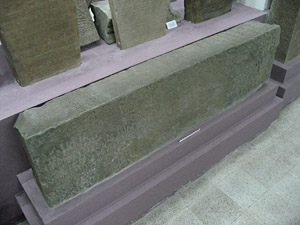
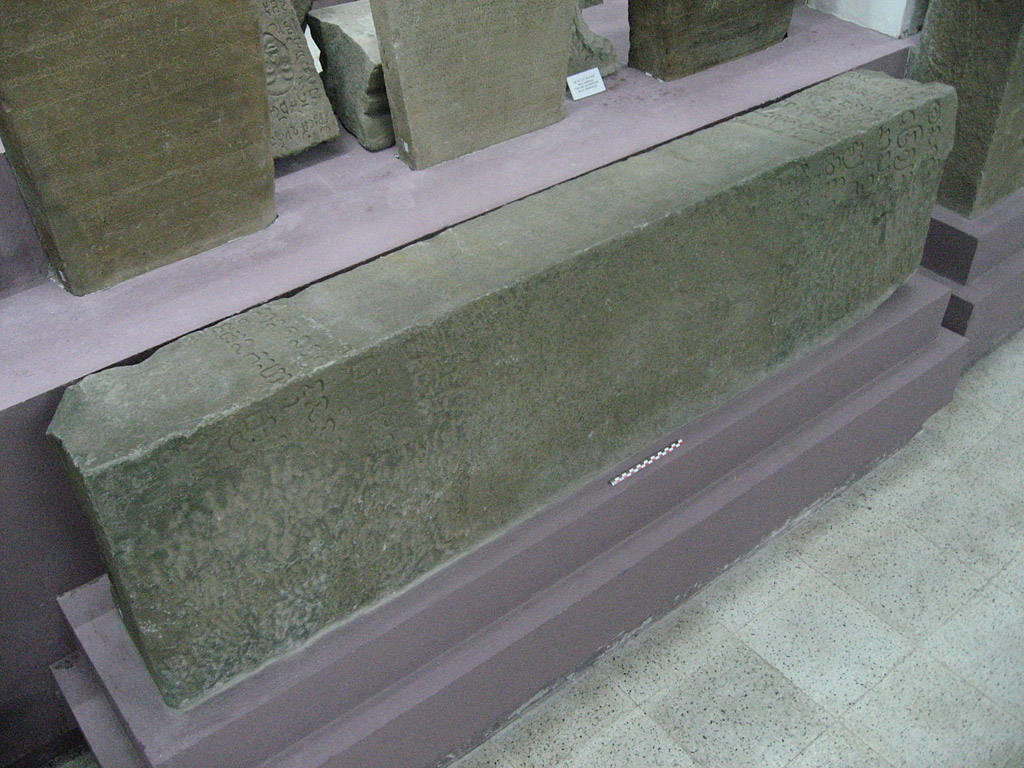
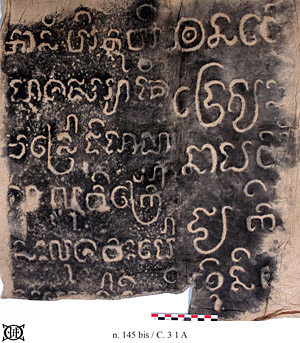
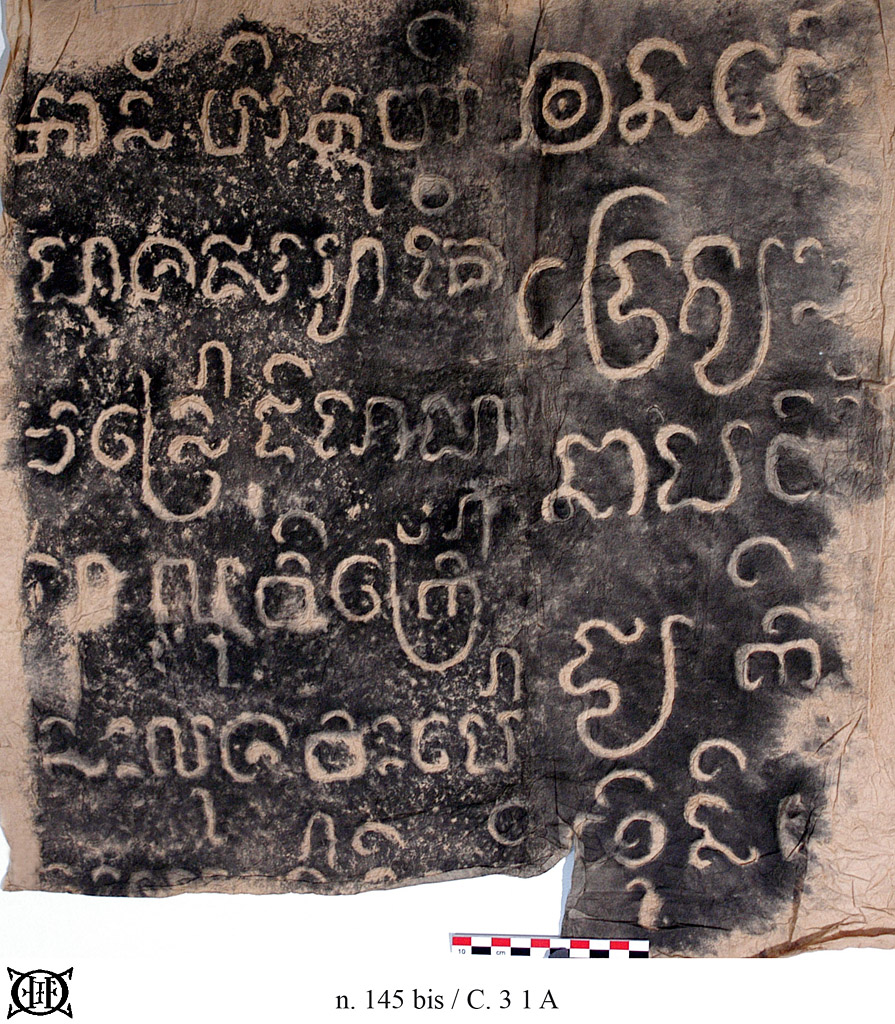
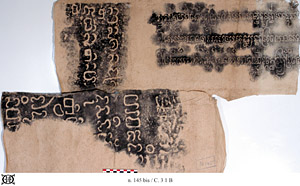



C. 3 Lintel from Phan Rang
Please note: you are reviewing a preprint version of this publication. Contents here may change significantly in future versions. Scholars with specific interests are urged to consult all cited bibliography before using our texts and translations or drawing other significant conclusions.
Text There are two distinct inscriptions on this stone: the first one was inscribed on two faces when the stone was used as a doorjamb (C. 3.1). When it was prepared to be re-used as a lintel, the original inscription was partially leveled and replaced by a new inscription (C. 3.2). The stone preserves the remains of 8 lines (front face) and 10 lines (right face) of the original inscription (C. 3.1). The new one (C.3.2) comprises 3 lines. Both text are written in Old Cam.
Date Text 1: 10th century Śaka; Text 2: 1155 Śaka (1233/4 CE).
Origin Town of Phan Rang (Ninh Thuân, Vietnam).
This lintel was found before 1888, when it was first mentioned in the literature (Bergaigne 1888: 88-89). According to this source, it was buried about 1 km from Cho Dinh, the principal market of Phan Rang along with the inscription C. 4 (the same information was repeated in Aymonier 1891: 57-58). In the absence of any other vestiges of a temple, Bergaigne 1888: 91 presumed these fragments to have been moved. At the beginning of the 20th century, it was observed at the Phan Rang residence (Parmentier 1909: 79-80). Like the architectural elements bearing C. 4, C. 5, C. 6 and C. 7, this one was later identified as belonging to a group of vestiges, found in the rice-fields of the Catholic Mission, to which the designation “sanctuaire de Svayamutpanna” was applied (Parmentier 1918: 77). When the inscriptions of Campā were moved from the Saigon Museum to the EFEO Museum in Hanoi in 1910, the collection was completed by other inscriptions regarded as being of outstanding importance for the history of Campā. The lintel bearing C. 3 was one of them (Finot 1915a: 2). Its inventory number B 2, 17 at the Museum was published in Finot 1915a: 10; whence, in the inventory of Campā inscriptions published in 1923, this local number was included under the entry C. 3 (Cœdès 1923). We identified the stone in the Bảo Tàng Lịch Sử Việt Nam (National Museum of Vietnamese History) at Hanoi in 2009 and following years, as the one bearing inventory number LSb 21164. The Museum assumed the new name Bảo Tàng Lịch Sử Quốc Gia (National Museum of History) in 2011, but this did not entail a change in the inventory number.
Edition(s) A few words were read in Bergaigne 1888: 88-89 and translated into French in Aymonier 1891: 57-58. The inscription was studied in Jacques 1976-1977: 989-991, but was integrally published for the first time ECIC III: 443-445 (cited in ECIC IV: 219-220), whence the present edition.
Facsimiles
- Estampage: BnF 382 (43)
- Estampage: EFEO 1
- Estampage: EFEO n. 145.1
The following text was edited by Arlo Griffiths and Amandine Lepoutre.
C. 3.1 A
(2) { ? } hajai 'yā ri cā
(3) { ? } manrauṅ· sā ha
(4) { ? } (hu)luv· kraum̃
(5) { ? } naḥ luvaiḥ pau
(6 through -3)
(-2) { ? } ntāna nai (ugra)
(-1) { ? } jma manataḥ ya
C. 3.1 B
(2) dre(g)(bh)ya(ḥ)(na){ ? }
(3) nāpa (mam̃){ ? }
(4) ṅyak· { ? }
(5) thun· { ? }
(6 through -6)
(-5) ya rāja di (na)[gara] { ? }
(-4) dunan· mam̃ { ? }
(-3) tva{ ? }
(-2) ru(pa) { ? }
(-1) niy(·) { ? }
C. 3.2
2 'yā ◇ as far as we know, this is the only attestation in the epigraphical corpus of the word with the idiosyncratic spelling 'yā, meaning 'water', that is preserved also in later Cam manuscripts (see Groupe de recherche cam 1977: 250). .
2 kāla (|) ◇ instead of a punctuation mark, one could read here the visarga sign. But the almost exact parallel in C. 92, face A, ll. 8–10 (urām̃ ya bhakti sadākāla ... ni prayojana samr̥ddhi bhanakti dadam̃n· kāla|, we have checked the text from the EFEO estampage n. 340) leads us to favor reading the daṇḍa sign. It also seems to offer, with urām̃ ya bhakti sadākāla 'man who is devoted at all times', a gloss of the expression bhanakti dadam̃n· kāla, found in those two inscriptions. — 3 tryā drim̃ ◇ we initially read tryam̃ dri, but if we read anusvāra-ardhacandra on the second syllable, we at least obtain one known word. — śrīpa(t)īśvara ◇ judging by the inked estampage, it would seem that there is a character between pa and (t)ī, and indeed Jacques 1976-1977: 989 has read Saratīśvara. But based on our inspection of the stone, we are certain that nothing is inscribed here.
Translations
English
C. 3.2
Hail ! Y.P.K. Śrī Jaya Parameśvaravarmadeva, while he was still (dunan yaḥ?) general, the illustrious Rāmadeva, this P.P.T.R. has carried out the installation of an image for Y.P.K Svayamutpanna, to the benefit of devotees at various times. [In the year] of the Śaka king 1155: he has offered Khmers, 9 persons; Siamese, 22 persons; a Paganese; a male elephant with a Khmer as master; a forest property trya ; person-soak-Mahendrapura. This god is called Y.P.K. Śrīpatīśvara.
French
C. 3.2
Salut ! Y.P.K. Śrī Jaya Parameśvaravarmadeva, alors qu’il était encore (dunan yaḥ?) général, l’illustre Rāmadeva, ce P.P.T.R. a effectué l’érection d’une image pour Y.P.K. Svayamutpanna, pour le profit des dévots à diverses époques. [En l’année] 1155 du roi des Śaka : [il] a donné des Khmers, 9 personnes ; des Siamois, 22 personnes ; un Paganais ; un éléphant mâle avec un Khmer comme maître ; un domaine de forêt trya ; personne-tremper-Mahendrapura. Ce dieu s’appelle Y.P.K. Śrīpatīśvara.
Commentary
Secondary Bibliography
- Parmentier 1909: 79-80.
- Finot 1915a: 2 and 10.
- Parmentier 1918: 77.
Notes
- There are three estampages under the number n. 145.



The estimation of the number of lost lines is based on calculation of an average of 9 cm per line; 103 cm between the top of the l. 6 and the one called -5 (C. 3.1 B).
this estimation of 14 missing lines on C. 3.1 A is based on calculation of an average of 8 cm height per line from lines 1 to 5, and of a 114 cm space between the top of the l. 6 and the top of the first bottom line. As the exact number of lost lines in uncertain, bottom lines are numbered negatively.